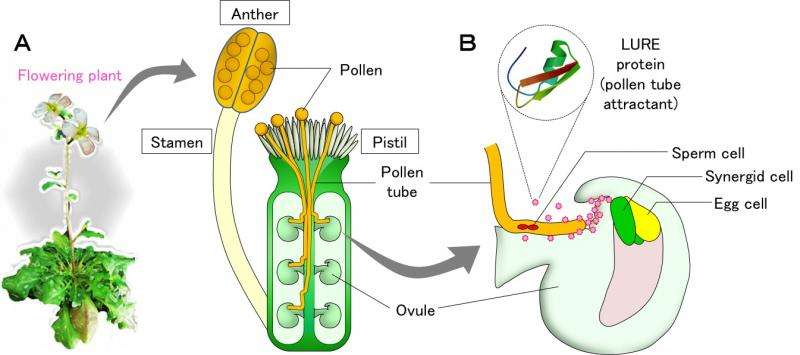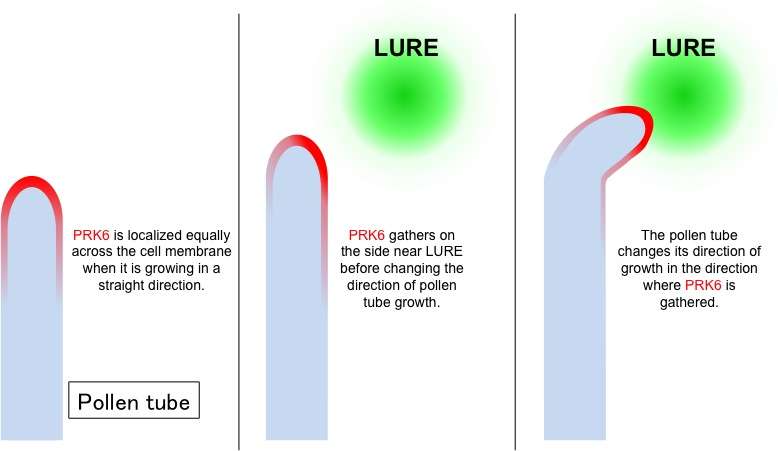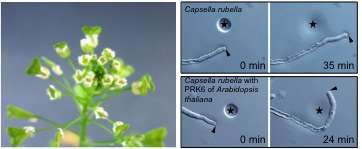Unraveling the unknown receptors and mechanism for fertilization in plants

Pollen tubes are attracted by LURE peptides, which are produced from ovules, to bring about fertilization. In their recent report published in Nature, a pair of plant biologists at Nagoya University has now revealed for the first time the receptor in pollen tubes that is required to detect LURE. Uncovering this unknown mechanism in plant fertilization may lead to an improvement in the efficiency of pollen tube growth, which may thus result in an increased success rate of fertilization. In addition, this study may also generate new methods to enable cross-fertilization between different plant species to generate new crops.
Nagoya, Japan – Dr. Hidenori Takeuchi and Professor Tetsuya Higashiyama of the JST-ERATO Higashiyama Live-Holonics Project and the Institute of Transformative Bio-Molecules (ITbM) of Nagoya University have succeeded in discovering a key kinase receptor in the pollen tubes (male) of flowering plants responsible for allowing the pollen tubes to precisely reach the egg cell (female) to enable successful fertilization, without losing its way.
Pollen tubes grow inside the pistil and deliver their sperm cell to egg cells, which are located deep inside the pistil, to bring about fertilization. Higashiyama's group has previously discovered a pollen tube attractant peptide, called LURE, which is produced by the ovule to guide the pollen tube toward the egg cell. Studies have shown that the structure of LURE differs for each plant species and is specific for each plant's pollen tube; i.e., each LURE peptide preferentially attracts the pollen tube of the same plant species. However, the exact mechanism on how pollen tubes detect LURE has been unknown up to now.

In this study, published online on March 10, 2016 in the journal Nature, Takeuchi and Higashiyama have discovered a receptor that is required for detection of LURE at the tip of the pollen tube for the model plant, Arabidopsis thaliana (thale cress). They also found that this receptor works with multiple receptors that have a similar structure, in order to precisely detect the signals transmitted from the pistil. By accepting the various signals sent from the pistil, the kinase receptors enable the pollen tubes to grow to a position inside the pistil where they can detect LURE. Subsequently, the pollen tubes are guided to reach the egg cell and pass on their sperm cells for fertilization.
"We believe that this study advances our understanding on the mechanism of fertilization between plant species," says Takeuchi, a postdoctoral researcher, currently at the Gregor Mendel Institute in Austria, who carried out this study. "Upon investigating the role of this receptor in further detail, we hope that this will lead to the development of techniques to alter the success rate in fertilization and improve the efficiency of seed production, as well as establish methods to enable fertilization between different species," says Higashiyama, project leader of the ERATO project and a Professor/Vice-Director at ITbM, Nagoya University.
Rice and soybeans that we eat on a daily basis are the seeds of plants and many vegetables develop from seeds. For plants to grow seeds, it is necessary for the male and female reproductive organs in plants to meet and fertilize. The male organ of flowering plants consists of pollen and the sperm cells within. Pollen develops into a pollen tube, which is a single cell with a tubular structure. The tip of the pollen tube (anther) extends and grows into the pistil. The pollen tube eventually reaches the egg cell deep inside the pistil, and passes the sperm cell to the egg cell to bring about fertilization.
The fact that pollen tubes are able to precisely find egg cells without losing its way may be the key element that supports our food supply. The meeting of male and female organs in plants is an extremely mystical and important event, but its exact mechanism is still full of mystery.

In 2009, Higashiyama and his colleagues discovered that a synergid cell, which is located next to the egg cell, produces molecules called LUREs that attract pollen tubes in Torenia plants. They also discovered similar LURE peptides in Arabidopsis thaliana in 2012.
"We found that the structure of LURE differs according to the plant species, and that LURE of a specific plant attracts pollen tubes of the same species, which preserves fertilization between the same species," describes Higashiyama. "Therefore, LURE has been identified as the key factor produced by the female organ to attract the male organ in plants."
Nevertheless, the mechanism on how pollen tubes can detect LURE, how the pollen tubes grow to a position inside the pistil where they can detect LURE, and the factors behind growth and responses of the pollen tubes have been unknown. Higashiyama's team decided to look into these questions by trying to unveil the key factors in pollen tubes that enable it to detect LURE.
"By using Arabidopsis thaliana as a model, we hypothesized that the 23 kinase receptors specifically localized on the membrane surface of pollen tubes could be candidates that are necessary to detect LURE," says Takeuchi. "I conducted bioassays of pollen tubes by deactivating the function of each kinase receptor and found that the PRK6 receptor was essential to detect LURE."

For PRK6, there are actually multiple families of receptors that have a similar amino acid sequence. Upon deactivating the function of other PRK receptors, Takeuchi and Higashiyama found that the loss of various combinations of PRK receptors led to reductions in responses of the pollen tubes to LURE or hindered pollen tube growth. This coincides with previous reports that the growth of pollen tubes is induced by the PRK receptor responding to the signals sent from the pistil. Hence, the team found that PRK6 and its other PRK receptors work together to detect LURE as well as enable pollen tubes to grow to a position inside a pistil where it can detect LURE.
Takeuchi next studied how PRK6 sends signals within the cells of the pollen tube to understand how it responds to LURE. "When the pollen tube is growing in a straight direction, PRK6 is distributed equally across the cell membrane," explains Takeuchi. "I used fluorescently labeled PRK6 and upon addition of LURE to the pollen tube, I observed that PRK6 moves towards the area of cell membrane on the tip of the pollen tube that faces LURE. The pollen tube then changes its direction and starts to grow towards LURE." From these results, the team showed that PRK6 collects the factors necessary for pollen tube growth in the direction of LURE.
"Although the attraction of pollen tubes is considered to occur preferentially between the same species, we wanted to see whether if we can make it occur between different species," says Higashiyama. Upon treatment of LURE from Arabidopsis thaliana to a pollen tube of a Capsella rubella (pink shepherd's-purse) plant, which is in the same Brassicaceae (Cruciferae) family as Arabidopsis thaliana, no response to LURE was observed.
"Interestingly, when we inserted the PRK6 gene of Arabidopsis thaliana into the pollen tube of Capsella rubella, it responded to the LURE of Arabidopsis thaliana," says Takeuchi. "This data shows that the PRK6 receptor in the pollen tube is surely the key factor to detect LURE of the same species. We were also really excited to see pollen tube attraction occur between a pollen tube and a LURE of a different species," say Takeuchi and Higashiyama.
The generation of seeds through the fertilization of the pistil by the stamen has been known for over 2000 years ago and is an extremely important mechanism in agriculture. In addition, the fact that pollen tubes are attracted to the pistil organ has been discovered over 100 years ago. Since the discovery of the attractant molecule LURE, the disclosure of the mechanism of response to the protein has been sought. This study reveals that the PRK6 receptor in pollen tubes is the main factor for detection of and growth towards LURE.
"By further investigation on the family of PRK receptors, we hope to unveil the full mechanism of fertilization that occurs through the growth of pollen tubes and the detection of LURE," say Takeuchi and Higashiyama.
"We also found in our studies that the insertion of a PRK6 receptor gene allows attraction of the pollen tube of a different species," says Higashiyama. "This may have potential in developing new methods to enable fertilization between different species. By exploring molecules that target PRK receptors, this may lead to the production of agrochemicals that can improve seed production by increasing the fertilization rate. We also envisage that this study will trigger new research to enable fertilization between different species to create new and useful plant species that can contribute towards a sustainable food supply," he continues.
More information: Hidenori Takeuchi et al. Tip-localized receptors control pollen tube growth and LURE sensing in Arabidopsis, Nature (2016). DOI: 10.1038/nature17413
Journal information: Nature
Provided by Nagoya University


















